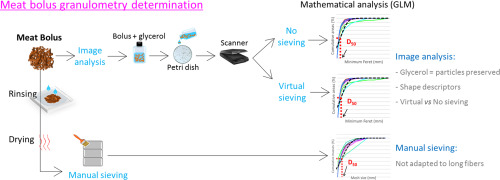Food Research International ( IF 7.0 ) Pub Date : 2018-10-04 , DOI: 10.1016/j.foodres.2018.10.014 Anne Duconseille , Olivier François , Pereira Bruno , Lambert Céline , Peyron Marie-Agnès , Hennequin Martine

|
People with poor oral status and/or neuromuscular deficiencies avoid eating meat because of chewing and swallowing difficulties. Consequently, they expose themselves to the risk of malnutrition and sarcopenia or nutrient deficiencies. To develop a new process for meat preparation, it is necessary to understand how meat is broken down during food oral processing to become a swallowable bolus. However, it is unknown whether the initial texture of meat impacts the meat bolus granulometry. As meat particles are fibrous, making the granulometry analysis with sieving methods is difficult. As the approach of meat bolus granulometry is necessary, it is of importance to control the methodological parameters that affect the measures. This study describes a procedure that allows granulometry analysis of shredded meat before and after in vitro mastication.
Meat particles were dispersed in glycerol before image analysis. Granulometry curves were then drawn using generalized linear models, particle by particle, or after applying virtual sieves. Artificial meat bolus granulometry was also analyzed by manual sieving and the different methods were compared through several characteristics, including D50. Image analysis in glycerol preserves meat particles and allows particle distribution characterization and shape descriptors analysis. This method is well adapted to shredded meat and could be performed to evaluate the mastication of meat preparations adapted for deficient mastication.
中文翻译:

测量体外咀嚼对切碎肉大丸粒度的影响:一项新方法学方法的建议
口腔状况不佳和/或神经肌肉缺乏的人由于咀嚼和吞咽困难而避免进食肉。因此,他们面临营养不良和肌肉减少症或营养缺乏的风险。要开发一种新的肉制品制备方法,有必要了解在食品口服加工过程中如何分解肉类以使其成为可吞咽的大丸剂。但是,尚不清楚肉的初始质地是否会影响肉团的粒度。由于肉粒是纤维状的,因此很难用筛分法进行粒度分析。由于必须使用肉团粒度测定法,因此控制影响该方法的方法学参数非常重要。这项研究描述了一种程序,该程序可以对肉丝的前后进行粒度分析体外咀嚼。
在图像分析之前,将肉颗粒分散在甘油中。然后使用广义线性模型,逐个颗粒或在应用虚拟筛网后绘制粒度曲线。还通过人工筛分分析了人造肉丸的粒度分析,并通过包括D 50在内的几个特性比较了不同的方法。甘油中的图像分析可以保留肉粒,并可以进行颗粒分布特征分析和形状描述符分析。该方法非常适用于切碎的肉,可用于评估适用于咀嚼不足的肉制品的咀嚼性。











































 京公网安备 11010802027423号
京公网安备 11010802027423号